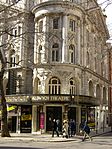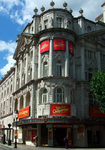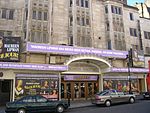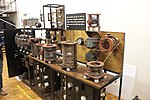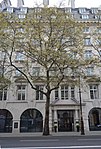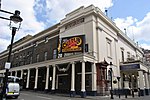The Theatre Royal, Drury Lane, commonly known as Drury Lane, is a West End theatre and Grade I listed building in Covent Garden, London, England. The building faces Catherine Street (earlier named Bridges or Brydges Street) and backs onto Drury Lane. The building is the most recent in a line of four theatres which were built at the same location, the earliest of which dated back to 1663, making it the oldest theatre site in London still in use. According to the author Peter Thomson, for its first two centuries, Drury Lane could "reasonably have claimed to be London's leading theatre". For most of that time, it was one of a handful of patent theatres, granted monopoly rights to the production of "legitimate" drama in London (meaning spoken plays, rather than opera, dance, concerts, or plays with music).
The first theatre on the site was built at the behest of Thomas Killigrew in the early 1660s, when theatres were allowed to reopen during the English Restoration. Initially known as "Theatre Royal in Bridges Street", the theatre's proprietors hired prominent actors who performed at the theatre on a regular basis, including Nell Gwyn and Charles Hart. In 1672, the theatre caught fire and Killigrew built a larger theatre on the same plot, renamed the "Theatre Royal in Drury Lane"; it opened in 1674. This building lasted nearly 120 years, under the leaderships of Colley Cibber, David Garrick and Richard Brinsley Sheridan, the last of whom employed Joseph Grimaldi as the theatre's resident Clown.
In 1791, under Sheridan's management, the building was demolished to make way for a larger theatre which opened in 1794. This new Drury Lane survived for 15 years before burning down in 1809. The building that stands today opened in 1812. It has been the residency of well known actors including Edmund Kean, comedian Dan Leno and the musical composer and performer Ivor Novello. From the Second World War, the theatre has primarily hosted long runs of musicals, including Oklahoma!, My Fair Lady, 42nd Street and Miss Saigon, the theatre's longest-running show. The theatre is owned by the composer Andrew Lloyd Webber. Since January 2019, the venue has had ongoing renovations, and in July 2021, the theatre reopened after over two years' of extensive work and closures related to the COVID-19 pandemic. Disney's Frozen made its West End debut at Drury Lane on 27 August, with general shows starting from 8 September 2021.
